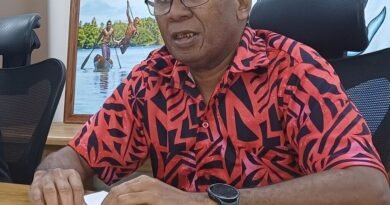Unforgettable Getaway Experience
LANGA Langa Lagoon, homeland of shell money, artificial islands, manmade boats and strong traditions
Together, lets go on discovery trip with Taiwanese Mandarin Teacher, Kuei-Mi Li, who recently went on extraordinary journey into coastal region of Langa Langa Lagoon in Malaita province.
In her own words:
Admiring beautiful shell money of different colors and designs at Honiara’s central market has always been one of my favorite activities since I arrived in Solomon Islands. As my stay extends, my understanding of SI culture also deepens a little more, and I got to know that the shell money making is closely linked with Langa Langa in Malaita province.
Actually, the first time I heard about Langa Langa was when I read a special issue on Solomon Islands on a Taiwanese magazine called Renlai Monthly, in which Solomon cultures, including shell money, were introduced in depths. But the book that really boosted my interest in this region is Birana I Wala, published last year, written and edited by a group of Langa Langa elders and a Taiwan anthropologist Pei-Yi Guo. I was so amazed by the unique traditions described in the book and thought if the occasion presents itself, I would love to see at firsthand how these traditions survive. And then the occasion presented itself. When one local tourism operator wanted to launch its Malaita tour, I became the first privileged guest to whom Langa Langa’s rich culture was shown in the most authentic way.
An agreeable boat ride from Auki wharf took me into the glassy lagoon. During a less than 30 minutes wave less ride, charming tiny coral islets with rustic sago palm pole houses caught my eyes, so this is it: the age-old manmade islands built by the legendary salt-water people. And I myself was going to stay at one such island which took 11 years to be completed!
At Foufalla Lodge, I was fascinated when one of the island builders told me how they go to search the coral rocks in the sea, bring them to the surface, transport them with canoe, and use only a metal bar to lift them. Later on I had the chance to see people building a new island by piling big reef stones one on another, and it’s definitely a laborious job. With all the idyllic beauty these tropical manmade islets may present, they face however some serious challenges, such as sea level rising; scarcer and scarcer coral rocks and lack of soil for farming.
But what makes Langa Langa most known is its shell money which is still used as a currency, and it’s widely believed that shell money making started from here. What is certain is that the shell money making is very present in Langa Langa, whenever et wherever I went during my 2 days stay in the lagoon, I could always run into a piece of shell money that was in a certain step of making, whether it’s breaking, drilling or stringing. Shell-money making is just part of the daily landscape of Langa Langa.
Another sight that impressed me during my trip to Langa Langa is the manmade wooden boats. I discovered that Langa Langa people are not only good at making shell money and artificial islands, but also boats. However, it’s also the same sight of these boats that made me feel sorry, because many of them are waiting to be finished or maintained, and it’s been a LONG while (10 years! 20 years!) that they are waiting, due to lack of funds. It’s a pity, especially as Langa Langa seems to possess great potentials for becoming a hub of local boat-building industry.
One of the highlights of my stay at Langa Langa is the visit of Laulasi, where I had a wonderful chance to watch the traditional dance and even dance with the performers. But what fascinated me more is the meeting with the acting priest. Langa langa might be one of the last strongholds for traditional beliefs after Christianity was introduced into the country in the 19th century. I was very touched when the acting priest answered to my question about his struggle between being a Christian and a servant of the Devil (ancestral spirits), it’s indeed an ambivalent role hard to play, and is also kind of epitome of Solomon society (and other indigenous communities in the world) looking for its balance between traditional values and outer influences.
Before leaving Laulasi, I was shocked when the acting priest pointed to an unnoticeable spot with messy leaves and branches, and told me that’s a memorial for the dead of WWII. In reality, this island was bombed in 1942 by the Americans who mistook Laulasi for a Japanese camp, which resulted in the killing of 18-24 people, according to different sources. What shocked me was this tragic bombing qualified as “the worst loss of civilian lives in the entire Solomon Islands conflict”, but what’s even more shocking is the lack of a decent memorial at the site to commemorate the innocent lives lost in a battle to which they had no direct connection. Something solemn should be set here to remind people of this unnecessary tragic loss caused by the atrocity and absurdity of the war.
As a first-time visitor, I found Langa Langa full of touristic interests, it has natural beauty, manmade wonders, traditional customs and historical memories. I have had the chance to experience local way of life in a genuine way and I am grateful to Langa Langa for offering its humbled visitor this unpretentious beauty.
Source: Kuei-Mi LI

